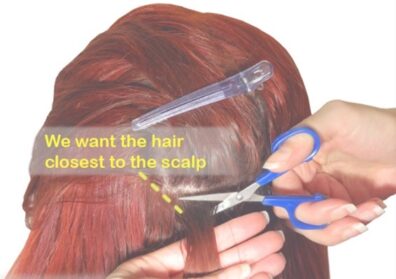Hair Hormone Concentrations
Research shows that extracting hormones such as cortisol, estrogen, testosterone, progesterone, and other metabolites such as THC, from hair, is a reliable method to accurately measure concentrations over a long-term basis (Russell et al., 2011). Whereas, serum such as blood or saliva gives a more instantaneous measurement of concentrations. Below is an image explaining how your hair will be collected and processed.
Hair Collection FAQs
Q1) Where should I take the hair from?
Feel the nub at the back bottom of your skull, take the hair sample from just lower than that. This way, the cut section won’t be seen with your hair down or up.
Q2) How much hair should I take?
Cut as close to your skin as possible without cutting yourself but the amount should be a lock of hair with the thickness of the clicker end of a ballpoint pen, this is about ½ cm2 or 150-200 strands, depending on your hair type.
Q3) Should I wash my hair before the collection?
Not needed but make sure to record the condition of your hair the day you collect it in the survey we distributed to you.
Q4) Can my hair be wet when I collect it?
You can collect the hair when it’s wet and then tie it with a rubber band or string to keep it in a lock. But let it air dry before you package it to send back to us.
Q5) My hair is dyed, bleached, relaxed, or permed, does that matter?
No, it’s okay that your hair is dyed, bleached, relaxed, or permed. Just make sure to record that in the survey we distributed to you.
Q6) Can someone living in my home collect my hair for me?
Absolutely! Just make sure they read the instructions beforehand.
Q7) Does my hair type make a difference?
No, as long as your hair is longer than 3cm (1.5 inches), we will be able to process it no matter what type of hair you have.
Q8) Do I need special scissors?
No, as long as the scissors are sharp, they should work just fine.
Hair Collection Instructions
Asking someone to help with this procedure would make it easier, although it is possible to do this on your own if you can clip your hair and choose a section lower to the base of your head.
- Select hair from a spot on your head that you would consider “discreet” this is often at the base of your skull near the back.
- Pinback the rest of your hair so you can clearly see/feel the section of hair you want to cut.
- The amount of hair should be around 200 strands (1/2 cm2 or the surface area of half your pinky’s nail, or the thickness of the clicker on a ballpoint pen)

- Hold on to the hair section and use scissors to cut the hair as close to your scalp as possible. Be sure not to cut your skin.

- Place the cut sample on the foil provided, scalp end closest to the end labeled “scalp” or “roots” and cover the middle with the tape provided.

- Fold the foil, enclosing the hair, to a size that will fit in the enclosed envelope.